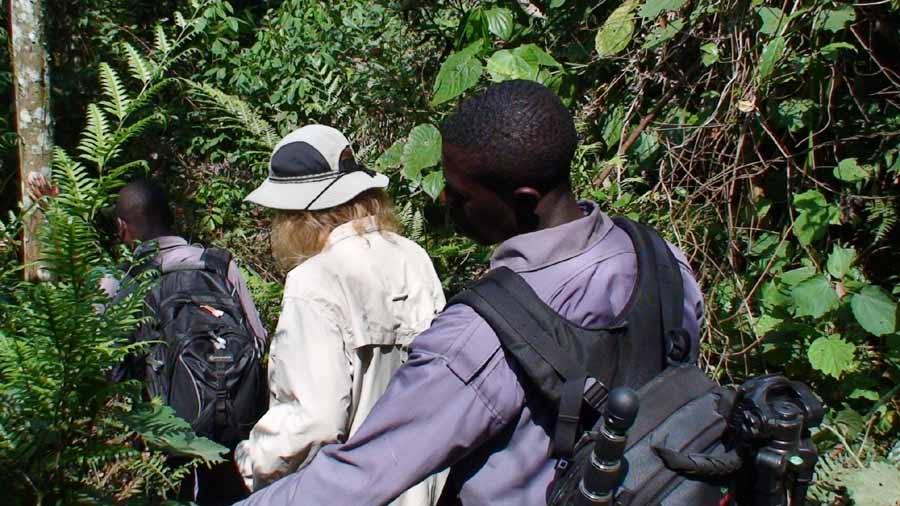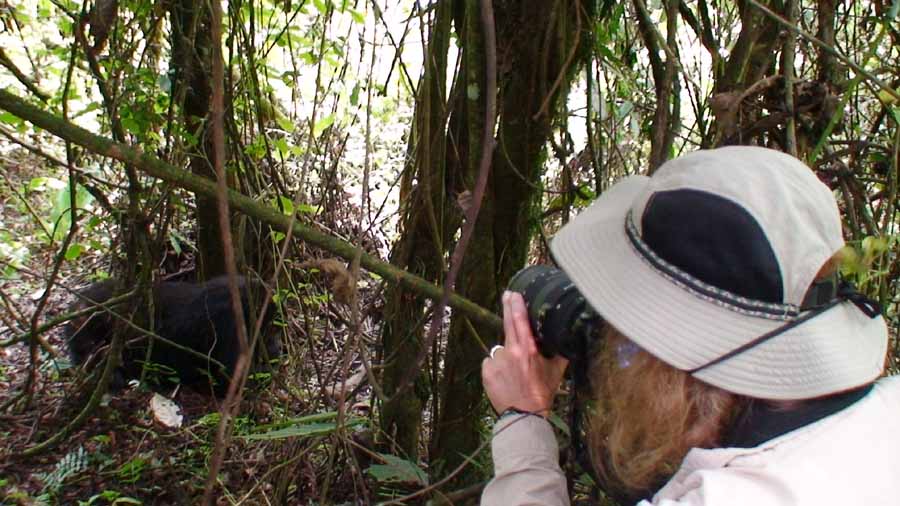| «Back to Previous Post |
Date: Friday, 4 July 2008 23:53:36 PDT
Subject: Greetings from Buhoma, Uganda
Captions for Pictures:
1. Our lodge in Buhoma
2. Trackers using machetes to clear a path for the visitors to view the gorillas
3. First (female) gorilla we saw
4. The distance between Sandy and the gorilla
5. Views from our lunch point
6 – 9. Second day pictures of gorillas
10. One of the three waterfalls that we hiked to on the second afternoon
It is Thursday, 3 July 2008. We are awakened at our lodge by the voices of the staff this morning at about 6am as they prepared breakfast and attended to their other duties. Later, as the sun rose, we heard the birds make their exotic calls. At that moment, we were reminded how far we were away from home. There is no electrical grid in Buhoma (the name of the settlement that includes the buildings both inside and outside of Bwindi Impenetrable Forest National Park). It took 180km (111 miles) of poor dirt roads to get here and the nearest paved road is 85km (53 miles) away. Electricity is produced using solar panels with a generator to assist when the power requirements exceed the capacity of the batteries. There is no cell service here. The only way to get any bars (two on a good day) is to walk outside the park for 20 minutes to a high point in a banana field – this is called a “hot spot” by the locals. There is no Internet. Sure, there’s an Internet Cafe about a mile away. But, when we visited it, we waited for more then five minutes for the first page to render, so we gave up trying. Water comes from a nearby well.
Our purpose for coming to Buhoma was to see the mountain gorillas in the wild. We booked two days of tracking to increase our chances. Mountain gorillas are only found in three places in the world: Bwindi NP in Uganda, Parc National Des Volcans in Rwanda and Park National des Virungas in the Democratic Republic of Congo (which is currently closed). These three parks are actually a single connected region. There are 700 mountain gorillas left in the world. 350 of them are located in Uganda in Bwindi NP and the remaining 350 are found in the other two parks. Mountain gorillas are on the short list of the 25 most endangered animals.
In Bwindi (where we are), there are three groups of habitated gorillas. The park issues eight permits for each group for a total of 24 permits per day. Trackers were sent out two hours before the tourist group assembles for the day. They left at 7am (sunrise) to attempt to locate the M group (our target for the day). The trackers hike to their last known location to start their search. Then, they look for prints, broken branches and excrement (poop) to locate them. Besides our guide and the eight visitors, there were two armed rangers and the porters hired to carried bags. We were perfectly able to carry our day packs. However, we wanted to support the local community, so we ordered two porters. The group of porters rotates so individuals only get the opportunity to serve once every two weeks on average (less in the low season). Our cost per porter is $10 for the day. Our actual tracking started at 9am outside of the park at the visitors’ center. The hike was at a steep angle – approximately 45 degrees straight up. One of our group of eight was “totally out of training” so she was quickly moved to the front of the party to set the pace. The guide communicated with the trackers via walkie-talkie several times as we took breaks to rest.
Travel inside of the Bwindi Impenetrable Forest National Park was difficult and slow. This is because the gorillas move each day. By 11am (two hours into the tracking), the trackers still hadn’t located the group. About an hour after that, we got the good news that the M group of gorillas had been located. We continued to walk along the park’s boundary before entering at the best point for viewing. The guide and the trackers communicated with animal calls to help guide our group as we got close to the gorillas. When we were within 200 meters of the group, we met up with the four trackers. We then left our walking sticks and backpacks with our porters. Two of the trackers – one man and one woman – went with us and our guide toward the gorilla group.
The trackers that went with us used machetes to clear a path for the visitors. It took five minutes to reach the first gorilla – a female. Again, the trackers cleared the brush from in front of the gorilla while we maintained a distance of seven meters (park regulations). The purpose of this rule is to limit exposure of human diseases to the gorillas and vice versa. We could see her body, but not her face. All of the sudden, she became curious about all of the noise and broke the branch in front of her to give us a clear view. After about 10 minutes, one of the trackers once again used their machetes to clear a path to several other gorillas nearby. They are mostly silent. So, we had no idea what we would find. We were surprised to find the silverback male and another female. While the first female was in the shade, the male was in the sun. We got quite a few nice pictures here though he had his back to us most of the time. We next rotated to a third site where we saw another four members of the group. Unfortunately, the forest was dense here which made photography difficult. We were able to see four more gorillas including a baby. We spent a total of an hour with the gorillas.
Upon retreat, we met up with our porters and then moved to a high-point on the park border for lunch. The location provided excellent views of the forest canopy. We had the opportunity to take a different route back, traveling through fields of bananas, coffee and cattle. We had the opportunity to see gorillas a second time on the next day – this time the R group. While the M group was in the park, the R Group was outside of the park in a buffer area. Though this was not a totally natural setting; but the light was superior so that the photography was much easier. We took several pictures of the silverback plus got some clear shots of the females, juveniles and several babies.
Since we completed the second gorilla trek by 10:30am, we decided to take a guided walk to some nearby waterfalls. Besides the guide, we were accompanied by two armed guards – one in front and other in back. The guards provided protection from the animals, allowed the rangers to patrol the park and ensure that we didn’t break any of the park regulations. It was a lovely hike which started with a wide path that was built to link Buhoma to another village. The last half mile was along a stream, over four bridges to see three waterfalls – the last one was 90 feet high. We shared our lodge-packed lunch with the guide and the rangers and then returned to the village.
We will be leaving Buhoma at 8am for a seven hour drive to Lake Mburo NP. The first four hours and the last hour will be on dirt roads. The middle three hours will be on poorly-maintained paved roads. Once we are in the park (the last hour), we will begin a game drive followed by a guided savanna walk. This time, we will be accompanied by an armed ranger/guide and be on foot for two hours.
Miss you all,
Darren and Sandy
| «Back to Previous Post |










